Mystery Foto #41 Solved: William K. Vanderbilt Jr., Rosamund Vanderbilt & Robert & Edie Huntington
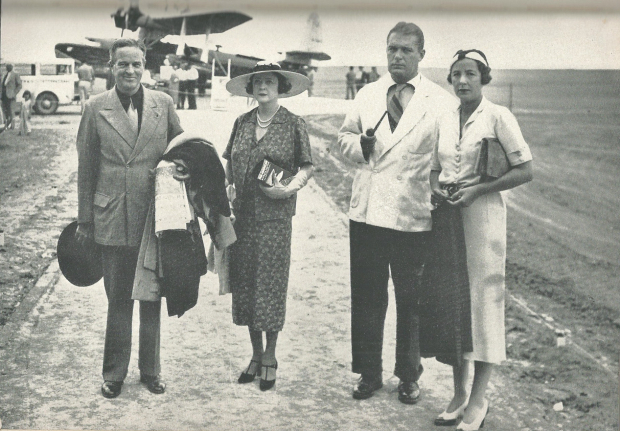
This weekend's Mystery Foto documented four friends traveling together.
Mystery Foto questions:
- Identify the four people (left to right)
William K. Vanderbilt, Rosamund Vanderbilt, Robert Dinsmore Huntington and Edie Huntington. The Vanderbilts of Centerport were friends of the Huntingtons of Mill Neck.
- Where and when was the photo taken?
The photo was taken on February 2, 1937 in the airport in Mendoza, Argentina. The Vanderbilts and Huntingtons were traveling on a tour of South America from January 18 to February 11, 1937. The journey was documented in Vanderbilt's 1937 book Flying Lanes which was dedicated "To Bob and Edie -Our Flying Companions".
- Identify the airplane
The Sikorsky S-43 seaplane owned by Willie K.
- Kudos question: What was the likely source of the family fortune inherited by the gentleman on the right?
Robert Dinsmore Huntington was likely related to Collis Potter Huntington who was one of the Big Four of the first transcontinental railroad, the Central Pacific.
Comments (8)
Congrats to Greg O., Steve Lucas, and Dick Gorman and Brian McCarthy for identifying the four friends.
Kudos to Greg O., Steve Lucas and Dick Gorman for identifying the likely source of Huntington's family fortune-railroads
Enjoy,
Howard Kroplick
TBRNews Media
Museum marks 80th anniversary of William K. Vanderbilt’s rare air journey around South America
Arts & Entertainment
by TBR Staff - December 12, 2017
Above photo:William and Rosamund Vanderbilt with Robert and Edie Huntington at the airport in Mendoza, Argentina with the Sikorsky seaplane in background. Photo from Vanderbilt Museum
William Kissam Vanderbilt II was an explorer and adventurer who traveled the world in his yachts. An avid race car driver, he set a world speed record in 1904, and brought auto racing to the United States. Vanderbilt also looked to the skies for diversion and adventure.
In early 1937, William and Rosamund Vanderbilt and their friends, Edie and Robert Huntington, flew around the Caribbean, Central America and the perimeter of South America in his 12-passenger Sikorsky S-43 amphibious airplane, from Jan. 18 to Feb. 11.
On Feb. 2, they few over the Andes from Mendoza, Argentina, to Santiago, Chile, which, Vanderbilt wrote, “can be very treacherous … as meteorological conditions in this area change rapidly.” He arranged with the Panagra airline to have one of its pilots show his pilot through the high mountain passes. Altitudes were so high that the travelers occasionally had to use supplemental oxygen tanks.
This year, the Vanderbilt Museum observes the 80th anniversary of that adventure.
Hayden Hamilton, managing editor for the American Aviation Historical Society in Huntington Beach, California, said, “This form of tourist travel was extremely rare in this period, generally restricted to the uber-wealthy or well-heeled entrepreneurs.”
Vanderbilt kept a detailed log and journal of the 25-day trip. They traveled 14,217 miles in 101 hours, 40 minutes, and used 8,360 gallons of gasoline and 828 gallons of oil. Later that year, Vanderbilt privately published 1,000 copies of his book, “Flying Lanes — Being the Journal of a Flight Around South America and Over the Andes.” The volume was illustrated with aerial photos from Pan American Airways (PAA) and others taken by Robert Huntington.
Sikorsky built 53 S-43 airplanes. Most were acquired by PAA and only two were sold to private individuals, according to Hamilton of the AAHS: William Vanderbilt and Howard Hughes. Just as Vanderbilt donated his 264-foot yacht Alva to the U.S. Navy for service during World War II, he sold his Sikorsky plane for $175,000 to the U.S. government for similar duty in 1941. The Alva, converted to a patrol gunboat and renamed the USS Plymouth, was torpedoed in 1943 by a German submarine and sank off the coast of North Carolina. According to an unconfirmed report, Vanderbilt’s amphibious plane crashed on a flight to Trinidad.
From “Flying Lanes”: After leaving Fisher Island and Miami on January 18, 1937, the Vanderbilts and Huntingtons flew toward Cuba, where they made their first fuel stop. As they flew, Vanderbilt wrote notes about the flight and thought about the man he had hired to fly them, Earl F. White, whom he described as “one of the most reliable and resourceful aviators in the game.”
White, 49, had been a World War I pilot in the U.S. Air Service, the forerunner of the Army Air Corps and later the Air Force, from 1915 to 1919. His extraordinary credentials included making the first nonstop flight from Chicago to New York in 1919, during which he set the official world distance record of 727 miles. White inaugurated the world’s first scheduled night air-mail service, which operated 1914-1925. He flew for Pan American Airways on the Miami-Havana-Puerto Rico route, from 1928 to 1931, and began working for Vanderbilt in 1935.
Robert Huntington, also a licensed pilot (as was his wife), occasionally took the controls of the seaplane to give White a break, so that he could send and receive Morse code messages. Huntington flew the plane for 40 hours of the trip.
“I flew the ship eleven hours during the trip and have altogether 104 hours at the controls to my credit,” Vanderbilt wrote. “But I have no pilot’s license and my guess is — I won’t get one. A little too old to start at this game, but it is nice to feel one knows a little about the ship, and it gives one reassurance that he is not apt to have if he has never actually been at the controls. However, I did do the navigating during the voyage whenever we left the coast and was rather pleased with the results …”
“We dined with the American Minister and had a most enjoyable evening and, as 4:00 a.m. was our time for getting up, we were glad to drop into our beds at midnight.”
February 11 — To Havana and Miami: The Vanderbilts and Huntingtons arrived at the airport at 5:30 a.m. “A cup of coffee was all Rose and I could muster, but then we would be home tonight. Think of it! Home! My, how good that sounded.”
After a stop in Havana, the travelers were airborne again, bound for Florida. “American Shoals light appeared at 4:50 p.m.,” he wrote. “There was the good U.S.A. once more. What a thrill went through us!” After landing in Miami, Vanderbilt wrote, “I clasp Mr. White by the hand. ‘Congratulations from all of us, a wonderful flight!’…
“Our total mileage added up to a very considerable total of 14,217 statute miles and the flying time amounted to 101 hours and 40 minutes. We had enjoyed the thrill and adventure of the journey to the utmost, but now that we were home once more we were glad to rest where we were beyond the reach of an alarm clock.”
Close-Up
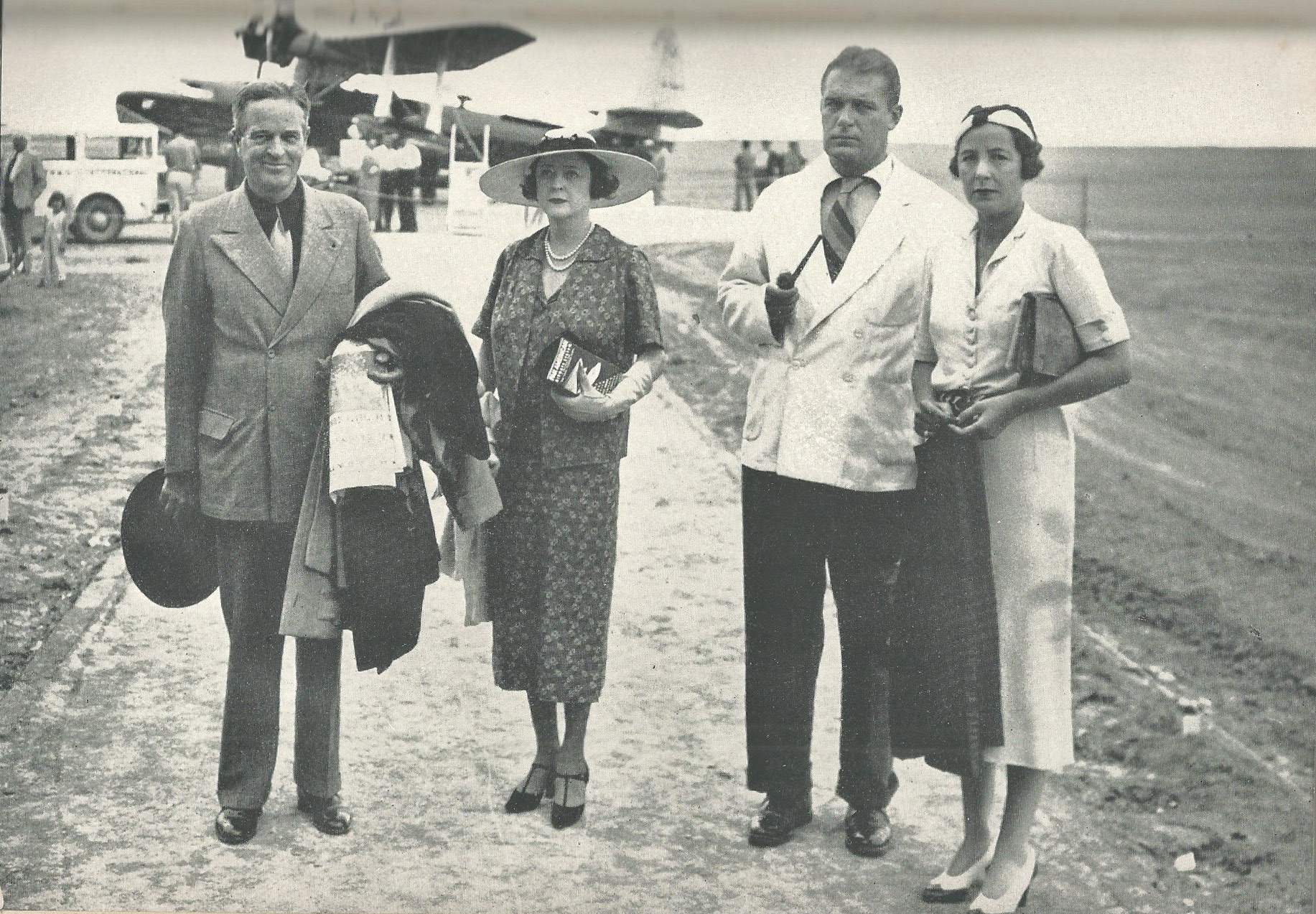
From the Book "Flying Lanes"
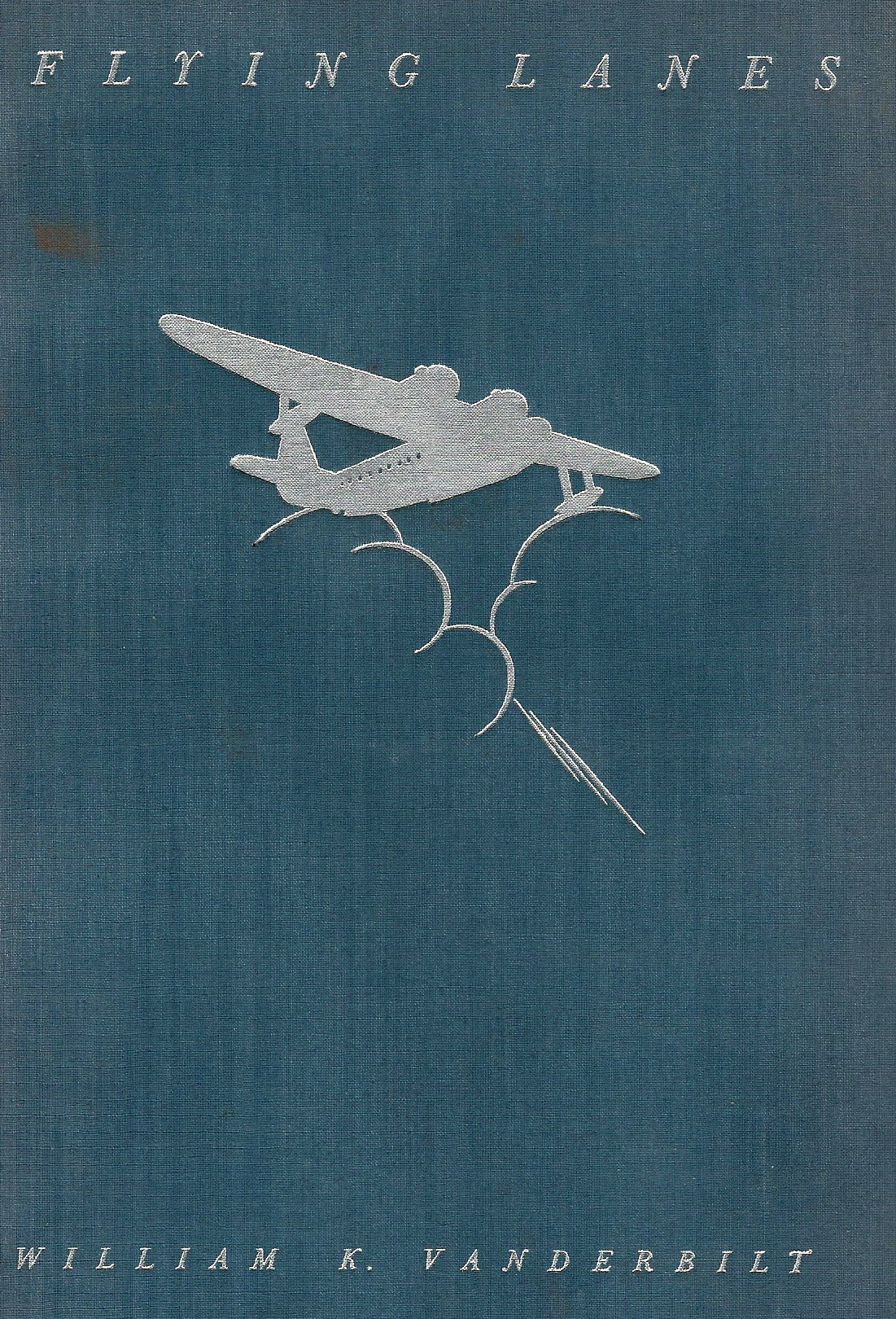
At the 2013 Doyle Auction of the Estate of Consuelo Vanderbilt Earl, I was the winning bidder for Consuelo's copy of the book signed by her father.
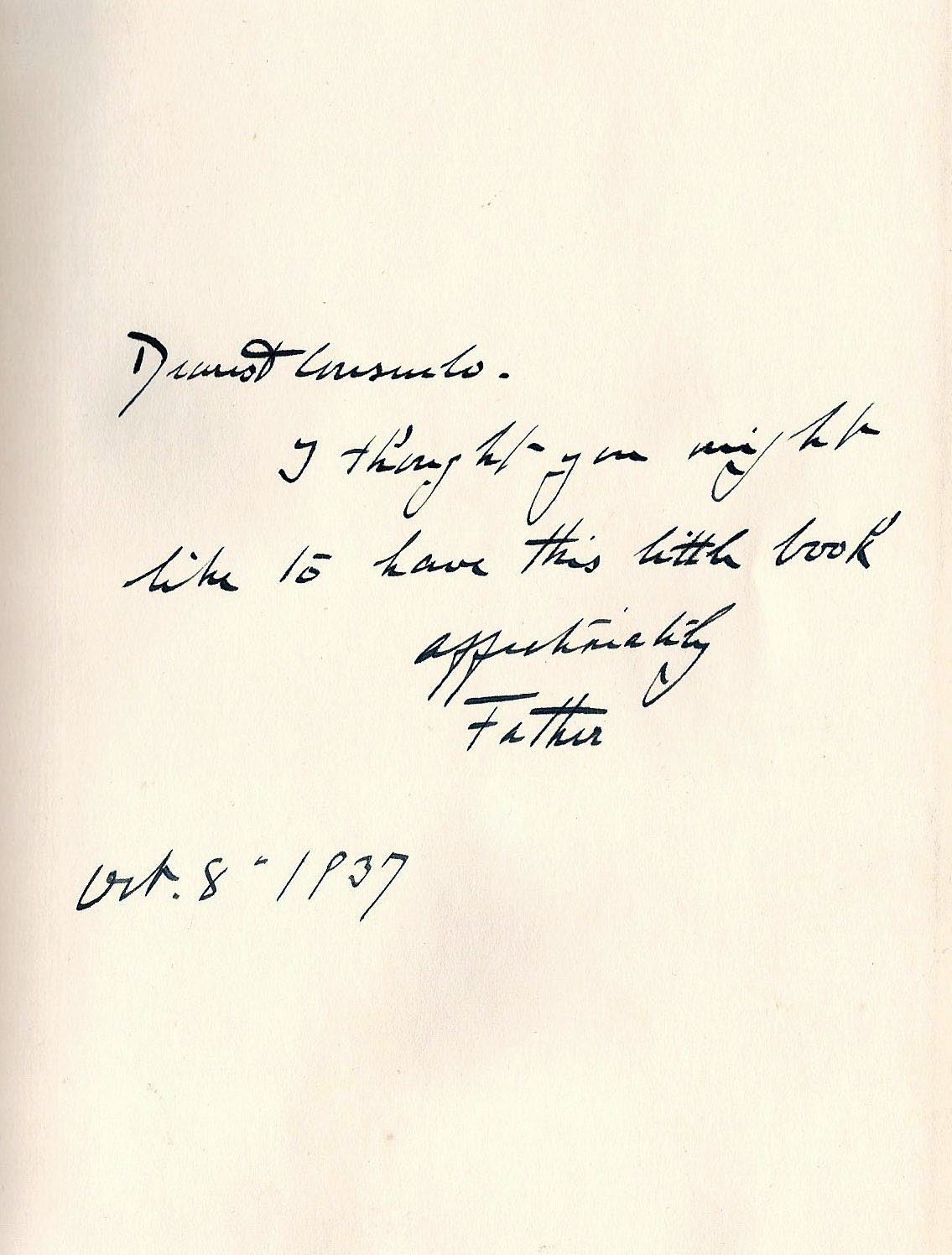
The inscription in the book reads:
Dearest Consuelo:
I thought you might like to have this little book
affectionately
Father
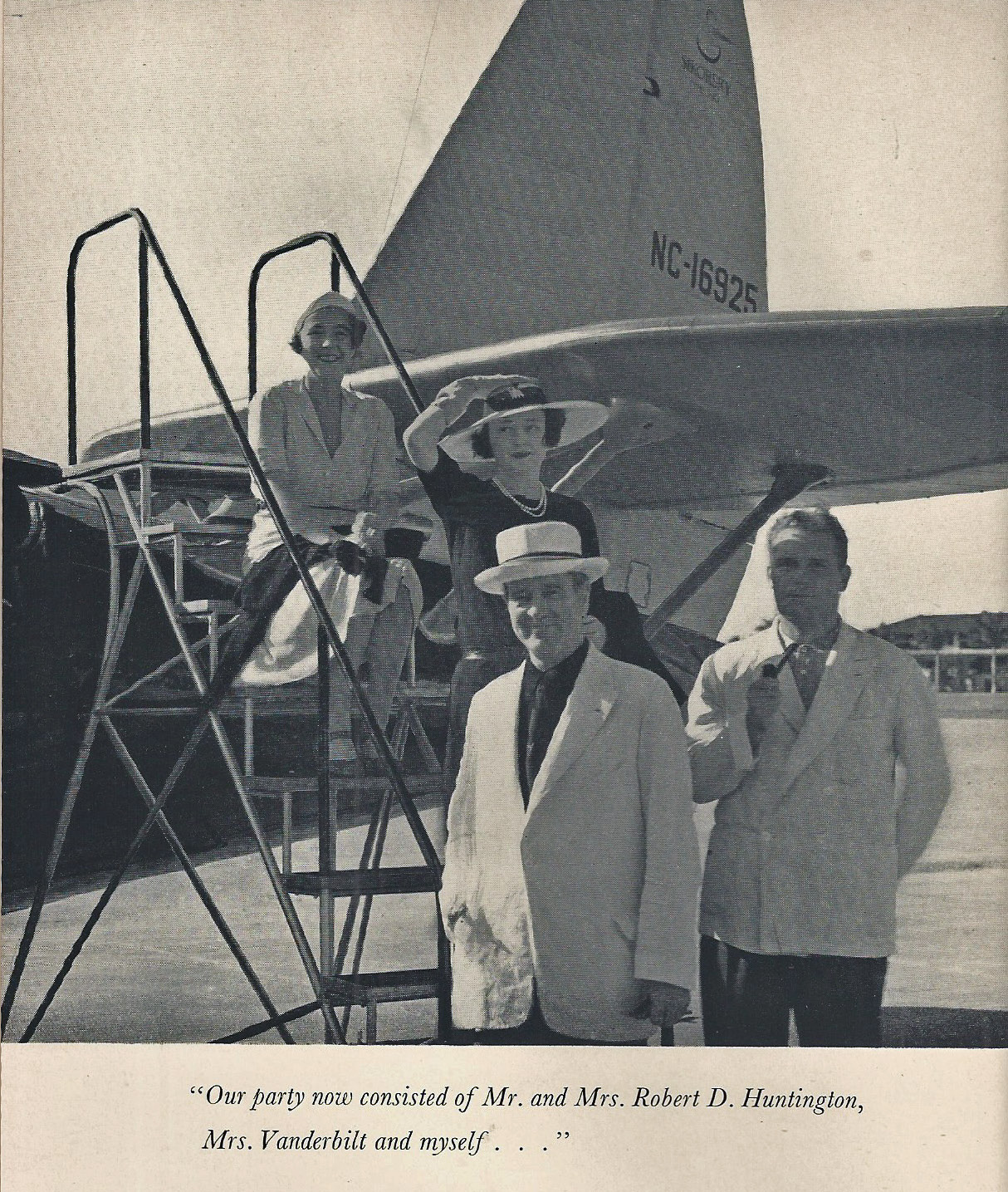
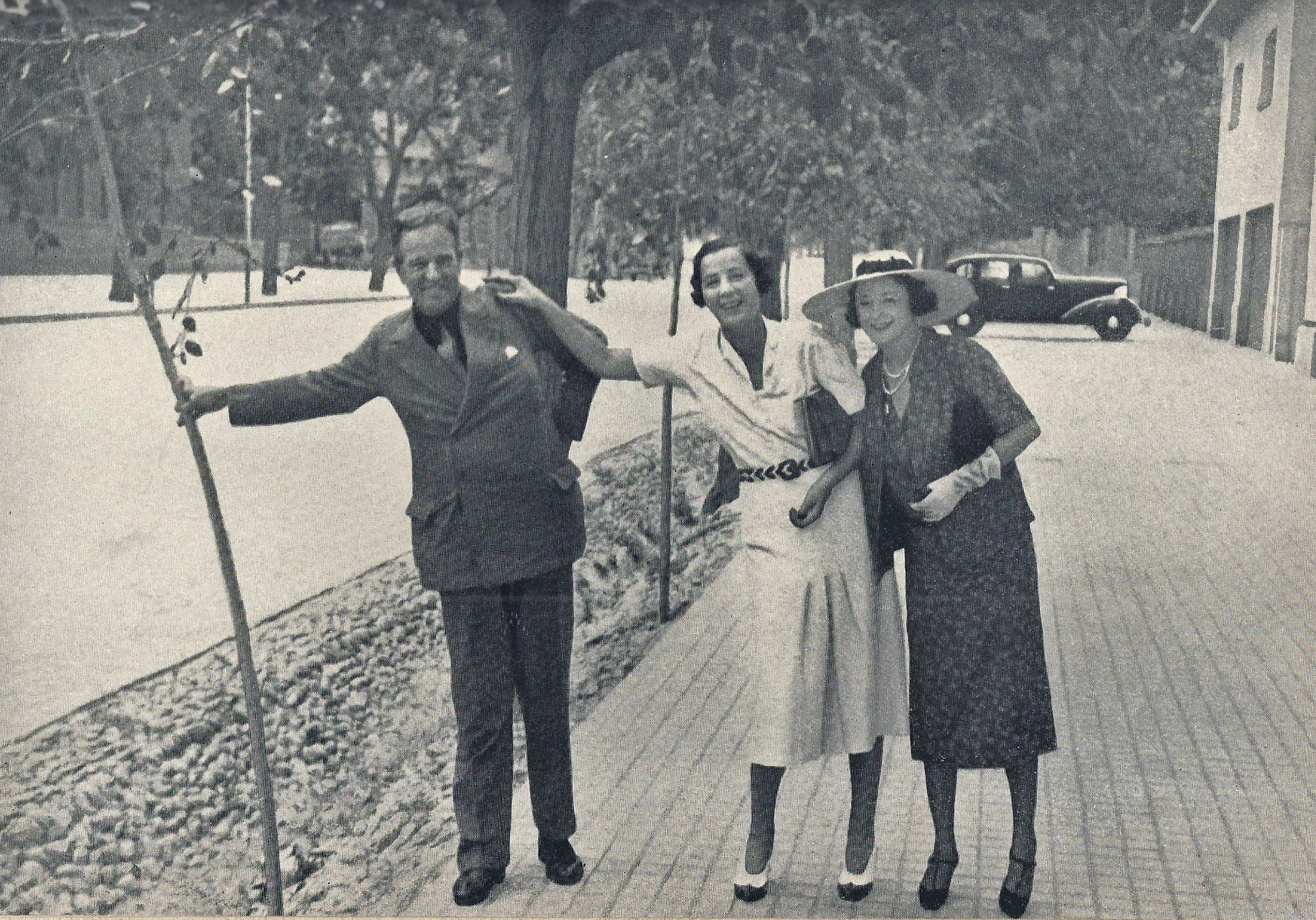
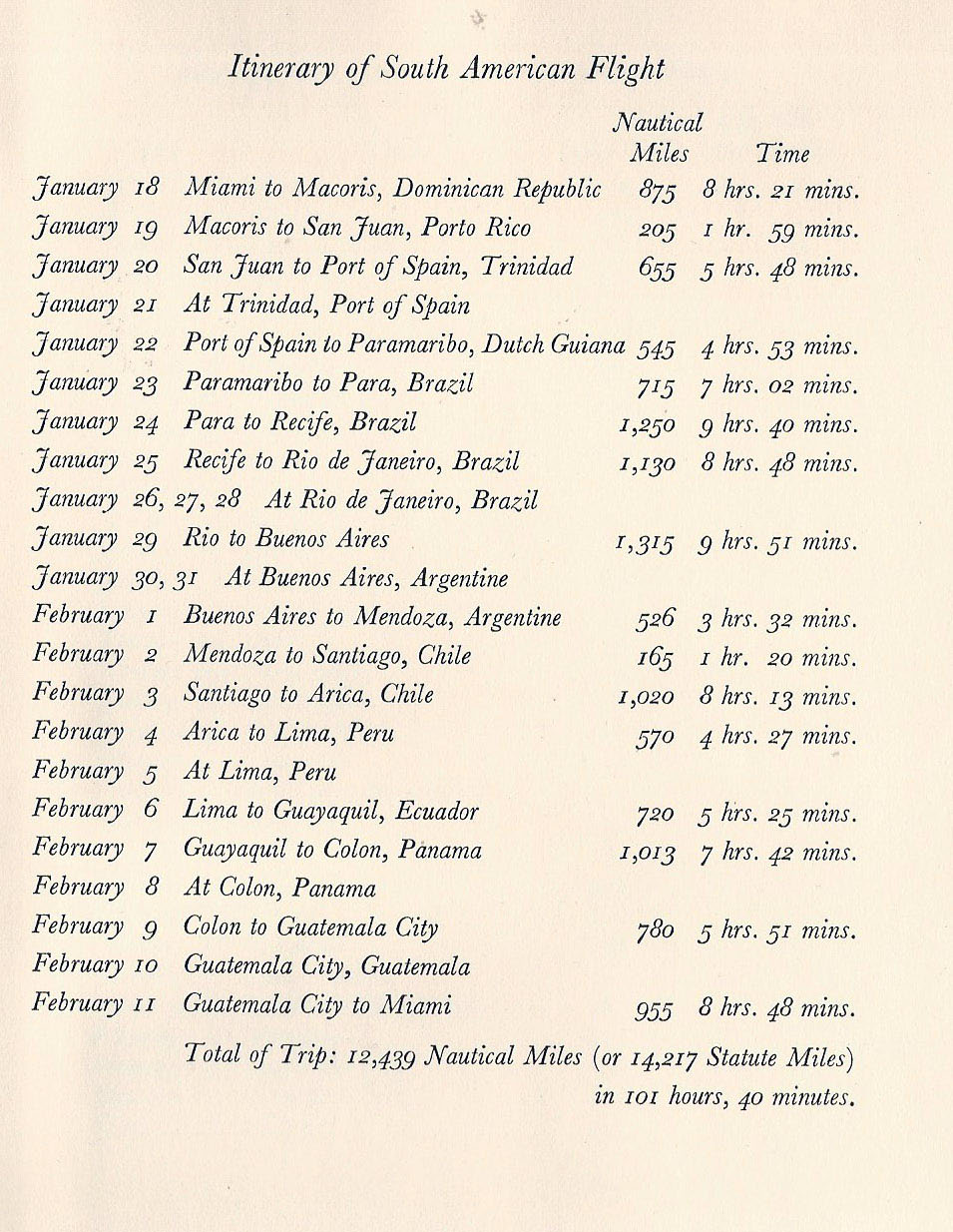
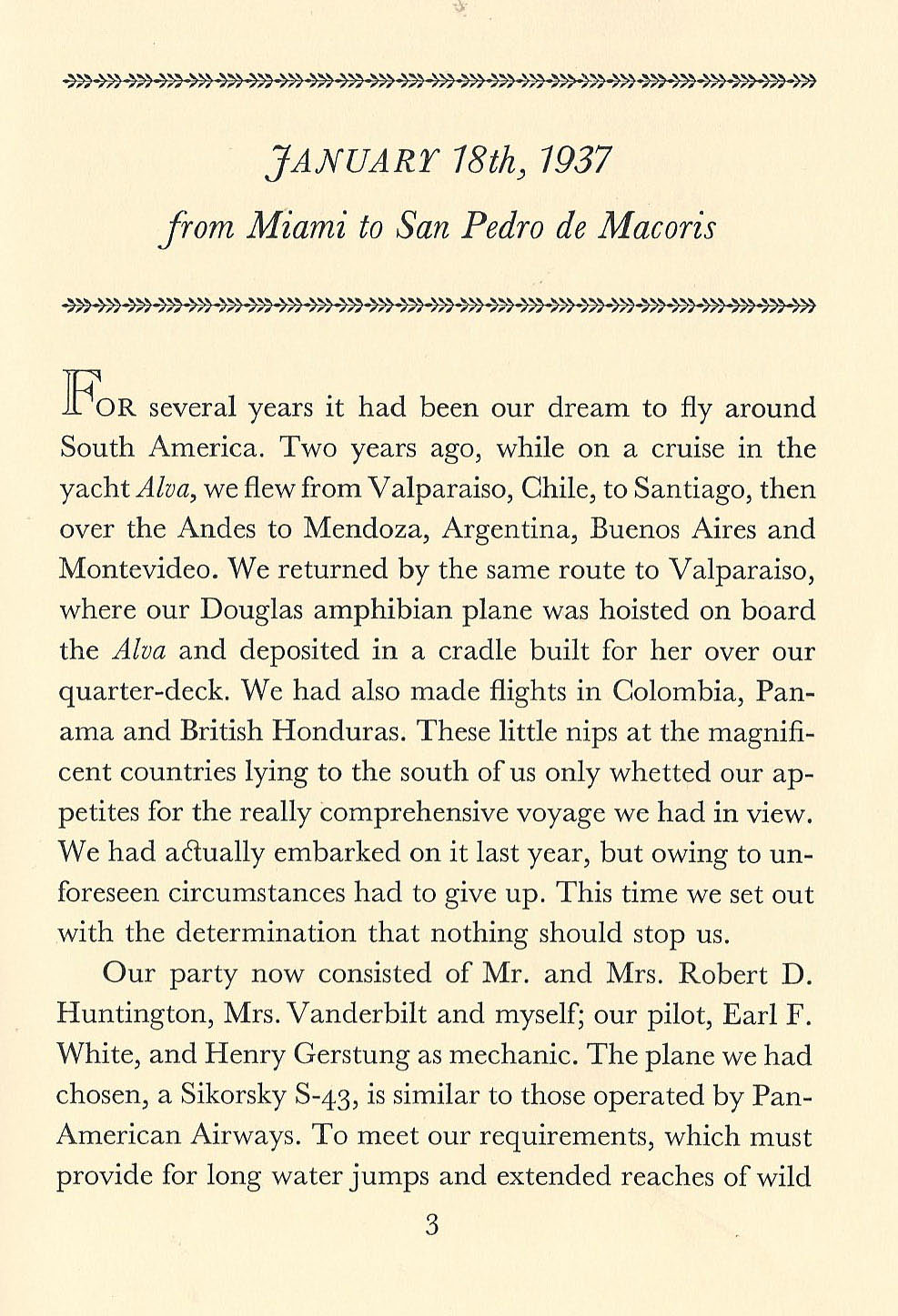
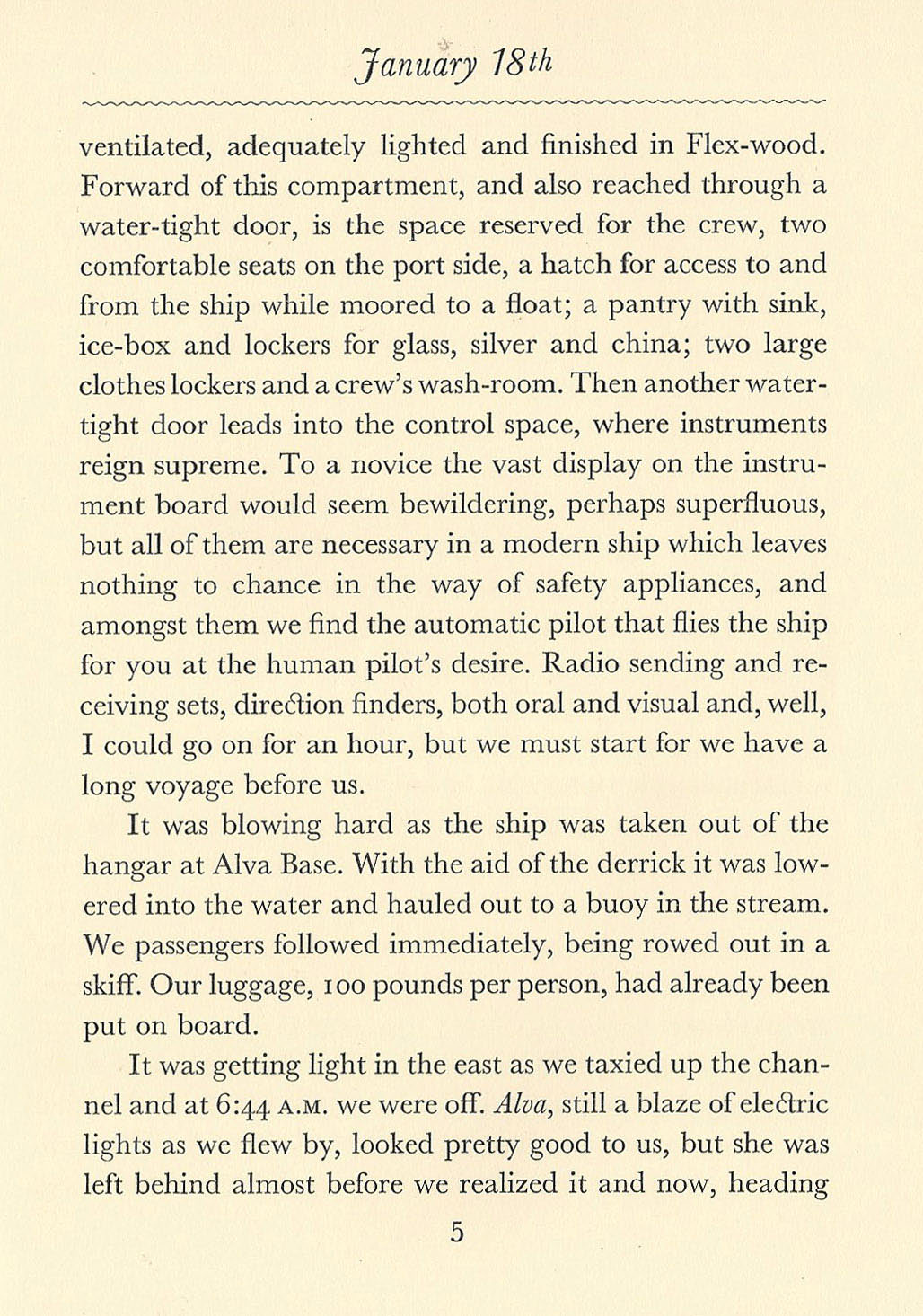
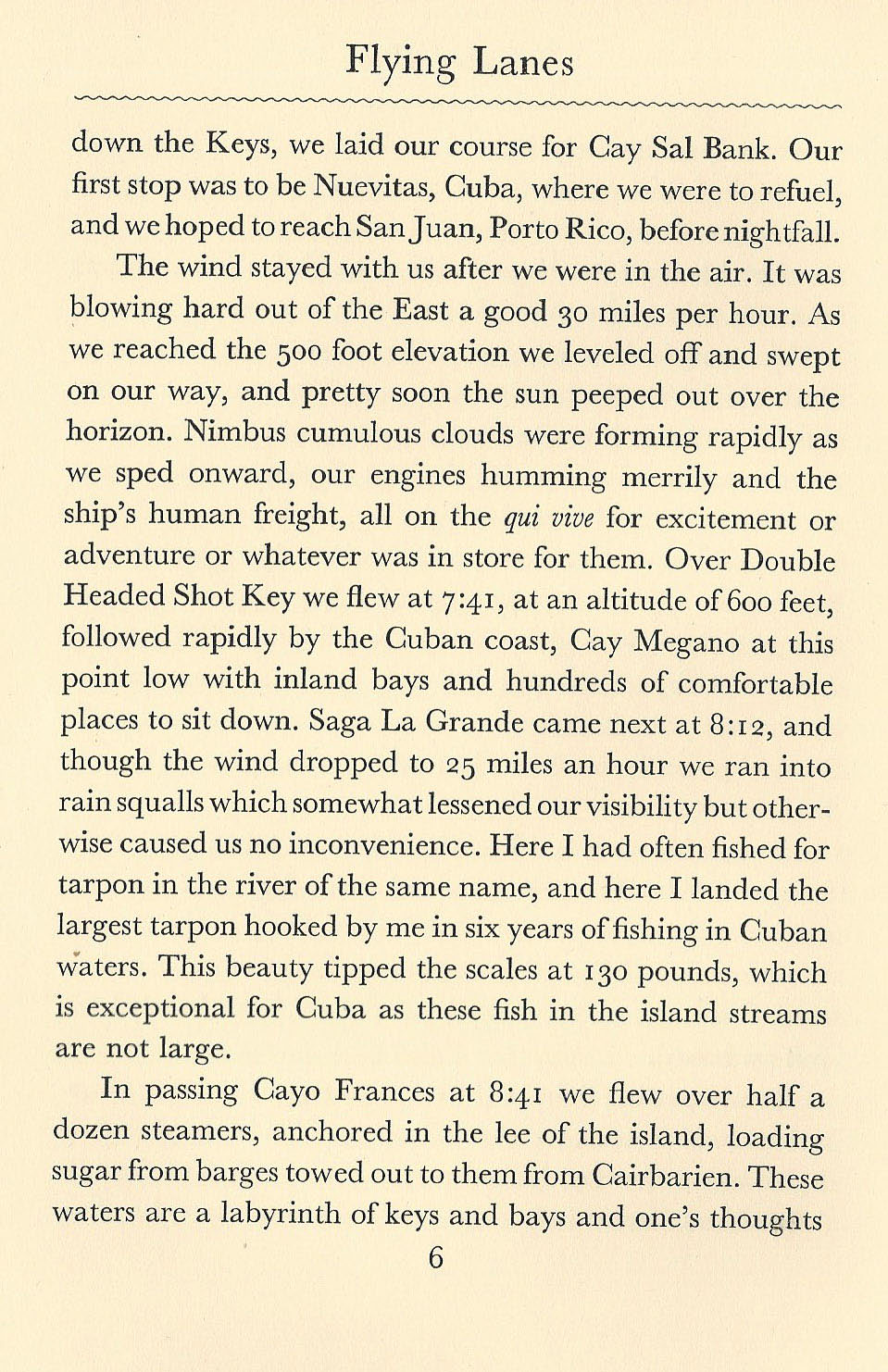

Comments
William K. Vanderbilt Jr, his wife Rosamund, and friends Edie and Robert Huntington flew around the rim of South America in Vanderbilt’s Sikorsky S-43 seaplane – from January 18 to February 11, 1937.
Here they are arriving at the airport in Mendoza, Argentina.
Kudos question: What was the likely source of the family fortune inherited by the gentleman on the right?
Robert Huntington’s family formed the Central Pacific Railroad
Mystery photo
William k Vanderbilt
Alva vanderbilt
Juan trippe
Wife?
Airplane Sikorsky s-43
Where port Washington harbor
Gotta run. Willie at left. His Sikorsky behind. LI Aviation Country Club (on the LIMP RoW)? Sam, III
Left to right we have: Willie K. Vanderbilt and his wife Rosamund; Robert Huntington and his wife Edith (Edie). The photo was probably taken in February, 1937 at the airport in Mendoza, Argentina during their South American tour which lasted from January 18 to February 11, 1937. The plane is Willie K.‘s Sikorsky S-43 Seaplane which was piloted by Earl F. White although both Huntington’s (who were pilots) and Willie K (who was not) had some time at the controls. Since the Vanderbilt’s had railroad money and there were several Huntington’s that made millions from railroads (Henry E. Huntington - Pacific Electric RR and Central Pacific RR; Collis P. Huntington & Archer M. Huntington), I’ll guess Robert’s fortune came from railroads also.
Can’t Identify anything. Lol. :D but think this image is historical
Mystery Foto #41…The four people in the photo left to right are William Vanderbilt, Rosamund Vanderbilt, Robert Huntington and Edie Huntington.
The photo was taken at Mendoza, Argentina on February 2, 1937.
The plane was a Sikorsky S-43, one of 53 built, only two of which were sold to private individuals.
A likely source of Robert Huntington’s inherited fortune…
I am afraid I must guess… transportation, railroads?
*ID the 4 persons: William and Rosamund Vanderbilt II, Robert and Edie Huntington
*Location/Date of image: airport in Mendoza, Argentina. Feb. 2 1937
*ID airplane: Sikorsky S-43 Amphibious owned by Mr. Vanderbilt II
I obtained these answers from ” tbrnewsmedia.com “, but had trouble forwarding the entire link here. Mr. And Mrs. Huntington were both licensed pilots. Robert occasionally piloted the seaplane, as well as Mr. Vanderbilt.
I assume they all voted for Alf Landon in 36!!!!
Not exactly FDR material.